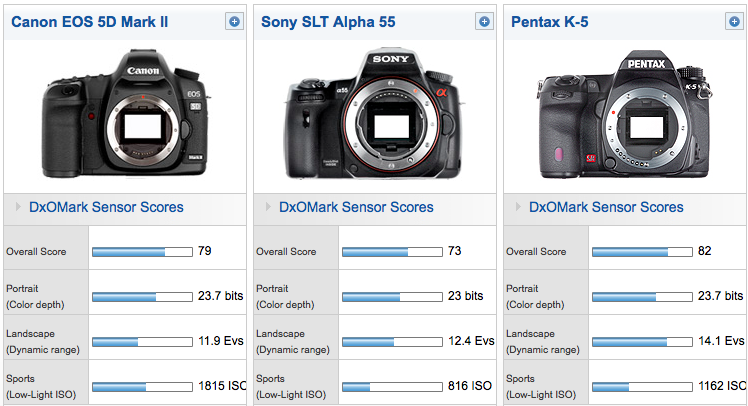 Originally posted by jsherman999
Originally posted by jsherman999 
How about when it isn't different? The K5/D7000 and D800 have exactly the same pixel size, yet the D800 has about a stop better performance.
I'm guessing that others have already commented on your Captain Ahab-like obsession with FF, JS!

But it leads you to howling errors, such as when you said: "
"Of course, you could just shoot with one format, too - the D810 - and just stop down 1.2. and then 2 stops to match the K-r and m43 DOF, and about match the noise and DR." and had to correct yourself.
This is another.
Again, if you're fixated by the light part of the signal-noise ratio, but not the
equally important noise component, you're going to struggle to explain this:

The K5 you use as your example beats the Alpha 55 at low light performance with the same sensor, a 1.6 stop advantage if the quoter of this source is to be believed. (BTW, we're told as gospel that full frame means more dynamic range, but look at the K3 versus 5D MkII, so again, there are obviously more important factors).
It may be hard for someone posting again and again about sensor formats to notice, but there are a lot of other components in a camera.
The K3 beats the NEX-7 with the same sensor by a similar margin (I just checked at DXO - 1216 to 1016), presumably because the NEX-7 is so small. The components are closer together, and the heat sink will be much smaller.
The designers of the Sony A7S went for a smaller number of bigger pixels versus what's in the A7 and A7R. They fear the noise that 4k processing might bring to their cameras, so they're behind Panasonic. The A7S has to offload the job to an external recorder by HDMI.
Samsung's NX uses BSI to cut down on noise between pixels, the optical equivalent of crosstalk.
IIRC, Pentax have said that an issue with FF is that the distinctive SR mechanism would need to be larger i.e more heat.
The 645Z's ISO improvements over the D come from CMOS technology, not a change of frame size.
So, JS, you say one thing, the designers of cameras say another.
Who should we trust?


 Similar Threads
Similar Threads 
















 Post #54 by Dartmoor Dave
Post #54 by Dartmoor Dave








